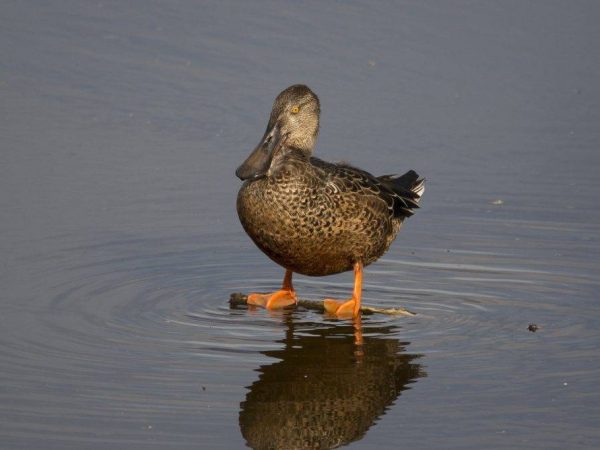Wide-legged duck
The wide-headed duck duck is a widespread species that lives in the Eurasian territory and in North America.

Wide-legged duck
External characteristic
Traditionally, the broad-mouthed duck is classified as a river bird, however, some ornithologists distinguish it as a separate genus. This bird is an object of fishing and sport hunting.
The size of the broad-nosed duck is slightly larger than the duck-like teal, but does not reach the size of the pintail. Its small growth in comparison with other relatives can be noted in the photo. In length it grows up to 52 cm, in a wingspan - up to 82 cm. The weight of the broad-bearer duck does not exceed 1 kg, starting from a weight of 0.47 kg. By its appearance, the feathered representative of the broad-nosed duck resembles a mallard, however, it stands out with a large beak (in males - up to 70 cm, in females - up to 65 cm), which looks disproportionately in relation to the overall size.
The color of females and males is significantly different, and this is clearly demonstrated by the photo:
- the drake, at the onset of the mating season, dresses in bright plumage, its black head and cervical region begin to cast green metal; a blue-green shiny shade appears on the back, above and under the tail, the sides of the body are covered with white stripes, and the flight wings acquire a bright chestnut color with a sparkling green mirror, the goiter and chest area are painted white, the eye iris of drakes is yellow or red. orange tint;
- the female has a predominantly brown color with streaks and light-colored upper feathers on the wings, the beak is olive green, and the eye iris is hazel.
The legs of both males and females are colored bright orange. In the summer, the drake becomes like a female, standing out only with the upper wings of a bluish-blue color and a brighter mirror.
Geography of residence
The widespread species lives in both hemispheres. In the southern European region, the duck nests in Spain, Corsica and France. In the northeast, these birds can be seen on the islands of Britain along the coast of the North Atlantic. They live in the south of Norway, in Sweden, flocks of broad noses have been recorded in Finland and Iceland.
Shirokoska is also present in Russia, preferring to settle in the region of Karelia, the Ob River delta, it can be seen near the Siberian Yenisei and on Taimyr.
The center of Europe is covered by this species, starting from Austria and Serbia, passing through the Czech Republic and Slovakia with Romania, ending in the Baltic States and Ukraine. The southern border of habitation runs along the Black Sea Turkish coast and the Transcaucasia.
Broad-nosed schools are noted in western North America, and in the north, the range ends in the Alaska region.
Lifestyle
The broad-mouthed duck is classified as a silent bird; it rarely demonstrates its voice. Most often, sounds are heard from males. They are two-syllable "kho-kho", pronounced dully and with smacking lips. With restless behavior, the sounds made by males are repeated many times and merge.
For broad-nosed ducks, open water bodies in the steppe or forest-steppe are a favorite habitat. There the flocks are most numerous. They settle in shallow waters near forest belts, on open lakes, or in wide river valleys.
The broadleaf duck is quite difficult to see in the tundra. There she settles only in the northeastern European part.
Shirokoska prefers to nest near water bodies where vegetation grows, avoiding forest rivers and lakes, to which the forest belt fits tightly; it is important for her to have a large open space.
In winter, the migratory duck moves to shallow bays and seashores in those zones where tides are noted. The feathered one can nest in marsh areas with fresh or salt water.
Diet and reproduction
Reproduction
The broad-nosed puberty begins at the age of one year, but many birds come to reproduction only after reaching 2-3 years. The mating season is in mid-spring (April) - early summer (June), but pairs are formed even before arriving at nesting sites.
Females build nests 20-27 cm wide in the form of a hole in the ground to a depth of 10 cm, cover them with last year's grass and down, preferring treeless islets, meadows or bumps for this.
Broad-nosed nests can often be found in the nesting places of terns and gulls, since the cry of these birds in the form of an alarm helps the ducks escape from the attack of predators.
The ovipositor usually contains from 10 to 12 eggs, which hatch for 23-25 days.
Food
Broad-legged ducks are carnivorous ducks, therefore, in their diet they should have small crustaceans and mollusks, insects with larvae, which are filtered by the bird through the plates on the beak with the help of the tongue. Sometimes shirokoski feed on fish larvae and snails. In addition to insects and fish, aquatic vegetation is included in the menu. They collect food from the bottom, therefore in many photos you can see a duck with its head lowered into the water column so that only the tail sticks out on the surface. Often it spins in one place and creates a water funnel around itself.


